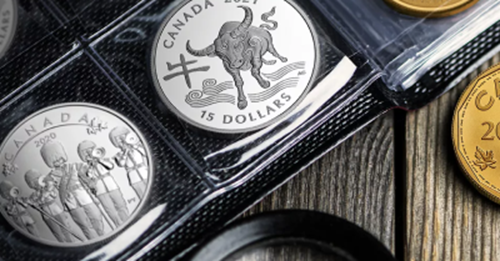Launching a legacy: Bluenose at 100
- Mar 25, 2021
- History
- 5 minutes read


The 2021 Bluenose Centennial Collection is our biggest commemorative program of the year and it represents a special anniversary for us – after all, Canada’s most famous ship has been sailing on our coins for more than 80 years. Be sure to check out our Bluenose Centennial Collection page to learn more about the Canadian legend and its famous journey from birth, to launch to champion.
But if you think you already know everything there is to know about Bluenose, test your Launch Day knowledge with these trivia questions!
Which shipyard built Bluenose?
- Smith and Weston Shipyard
- Smith and Rhuland Shipyard
- McGill Shipyard
- Mosher Shipyard
(Hint: You’ll find the answer here)

The answer: B. Smith and Rhuland Shipyard, located on the Lunenburg waterfront.
After the firm was awarded the contract for Bluenose in 1920, the shipyard became a hub of activity as the finest shipwrights set to work while local craftsmen stitched the sails and forged the hardware. Throughout its history, Smith and Rhuland Shipyards built, launched, repaired and/or restored more than 270 vessels – tugs, trawlers, freighters, yachts, and of course, Grand Banks schooners like Bluenose.
Here’s a bonus fact: Audrey Smith, daughter of shipbuilder Richard Smith, was the one who christened Bluenose on Launch Day.
How much did it cost to build Bluenose in 1920-21?
- $10 Million
- $3.5 Million
- $530,000
- $35,000

The answer: D. $35,000
While it might not seem like a big amount, it’s the equivalent to roughly $440,000 today. The money was raised by five sponsors who incorporated themselves as Bluenose Schooner Company Ltd. Some early crowdfunding was involved: most of the funds came from shares sold for $100 each to shareholders located in Lunenburg, Halifax and elsewhere in Canada.
How long did it take to complete construction of Bluenose?
- Two years
- A year
- A few months
- Eight weeks

The answer: C. A few months.
The keel was laid in late 1920 – a keel-laying ceremony was held in December – and just a few months later, on March 26, 1921, Bluenose was ready for launch. There was still more work to be done to outfit the ship, but on April 15, 1921, Bluenose set sail on its maiden voyage.
Why so little time? According to the rules, Bluenose had to complete at least one season (usually from March to October) as a fishing vessel on the Grand Banks in order to qualify for that year’s International Fisherman’s Race – the very race it was designed and built to win.
Who was invited to drive the ceremonial first spike?
- The Governor General of Canada
- The Prime Minister of Canada
- The Premier of Nova Scotia
- All of the above

The answer: A. The Duke of Devonshire, Victor Cavendish, then-Governor General of Canada.
The ceremony took place in December 1920, when the Governor General happened to be touring Nova Scotia. As the story goes, the Duke had attended a prior function and, well, he may have enjoyed himself a bit too much – he had some trouble driving in the spike and after a few swings at it, someone stepped in to lend a hand.
Name another famous ship built in Lunenburg, N.S.
- Bluenose II
- HMS Bounty (movie replica)
- HMS Surprise (movie replica)
- All of the above

The answer: D. All of the above
Fittingly, the second-most famous ship to come out of Lunenburg has to be Bluenose II. The namesake replica was constructed according to the original plans (plus a few minor alterations) and in the same shipyard as Bluenose. It was launched on July 24, 1963 and Bluenose captain Angus J. Walters was on board for the maiden voyage. The vessel was sold to the provincial government (for $1) in 1971; rebuilt and re-launched in 2012, it proudly sails as Nova Scotia’s tall ship ambassador.
A few of Hollywood’s floating stars have also been constructed in Lunenburg, N.S. There was the replica of HMS Bounty built for the 1962 film, Mutiny on the Bounty. And if you’ve seen the 2003 film Master and Commander, the stand-in for HMS Surprise was originally built in 1970 as a replica of an 18th century frigate.
Credit for photos within blog: W.R. MacAskill, Nova Scotia Archives, 1987-453 no. 235; W.R. MacAskill, Nova Scotia Archives, 1987-453 no. 427; Dewitt Herman, Fisheries Museum of the Atlantic, F97.201.4B; W.R. MacAskill, Nova Scotia Archives, 20040012; W.R. MacAskill, Nova Scotia Archives, 20040024.
Works Cited
“The Bluenose Is Born (1920-1921)”. Bluenose: A Canadian Icon, Nova Scotia Archives, https://archives.novascotia.ca/bluenose/results/?Search=&SearchList1=3
Roué, Joan. A Spirit Deep Within: Naval Architect W.J. Roué and the Bluenose Story. Vanwell Publishing Ltd, New Edition, 2002.
“Bluenose: The Story.” https://www.wjroue.ca/bluenose/bluenose/
“Smith and Rhuland Shipyard”. Lunenburg Waterfront Walk. http://lunenburgwaterfrontwalk.com/introduction--english/stops--english/stop-9-smith-and-rhuland-shipyard/



